“Bunyip: The Haunting Guardian of Australia’s Shadowed Wetlands”
The Bunyip, a lurking terror of Australia’s shadowed billabongs, rises from the depths with haunting cries and a form that blends beast, spirit, and nightmare.
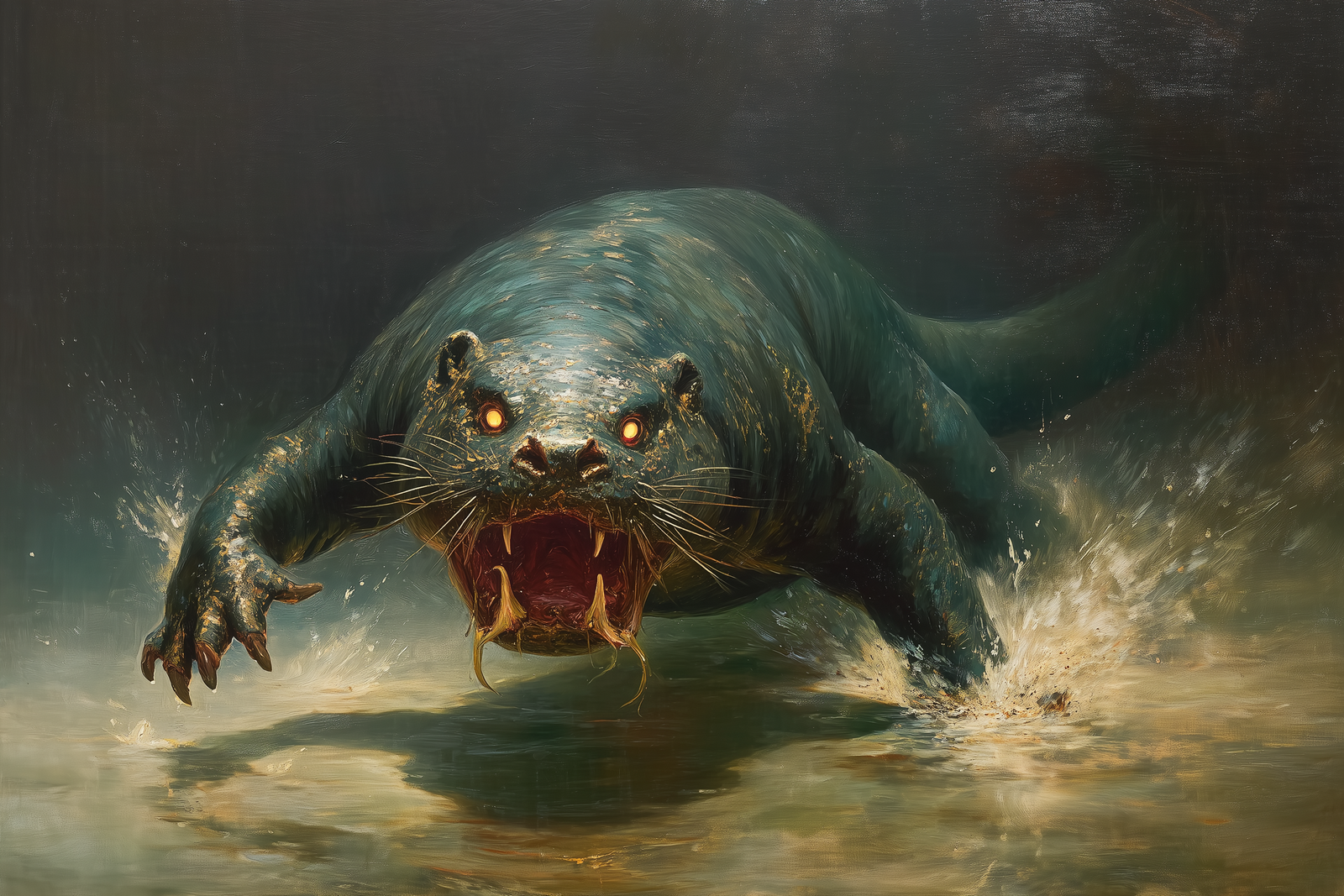
The Bunyip is a fearsome, amphibious predator of Australia’s shadowed wetlands, with tusked jaws, clawed limbs, and a serpentine tail, known for haunting cries that lure the unwary and a relentless instinct to guard its watery domain.
Appearance
The bunyip is a massive, amphibious predator with slick, dark hide mottled like river mud, long tusk-like fangs jutting from a wide maw, and eyes that glimmer with a ghostly pallor in moonlight. Its body blends reptilian bulk with mammalian traits: flippered forelimbs for swimming, clawed hind legs for dragging prey ashore, and a serpentine tail that churns water into froth.
Behaviour
The bunyip is a patient ambush hunter, preferring to lurk in still waters for hours, emitting low, mournful bellows that echo through the night. It is solitary and highly territorial, striking swiftly when disturbed. Tales speak of its uncanny cries—some say they mimic human voices—to lure the unwary closer.
Habitat
Bunyips dwell in swamps, billabongs, deep river pools, and mist-laden wetlands. They are fiercely protective of their chosen waters, rarely venturing far from them except during flooding rains, when they may travel across land in search of new lairs.
Modus Operandi
A bunyip attacks from concealment, bursting from beneath the surface to seize prey in its jaws or drag victims into drowning depths. In combat, it thrashes with its tail, rakes with claws, and unleashes a bone-shaking roar that unsettles creatures nearby. Legends claim particularly ancient bunyips may wield an aura of dread, sapping courage as surely as their fangs sap blood.
Motivation
Driven by instinct and hunger, bunyips seek living prey that strays too near their waters. Yet beyond mere sustenance, they embody the spirit of untamed waterways—guardians of forbidden places, punishing those who trespass. Some lorekeepers whisper they are cursed spirits bound to the water, hunting eternally for those who broke ancient taboos.
Bunyip, 5e 2024
Bunyip, 5e
Bunyip, Pathfinder
Bunyip
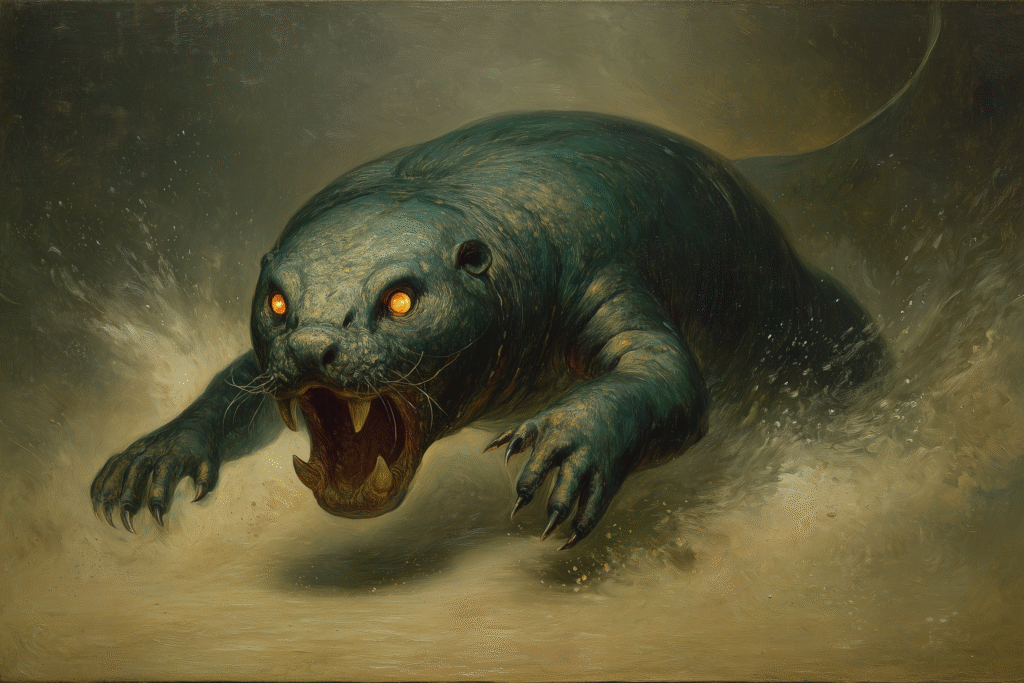
Large monstrosity, chaotic neutral
Legends speak of the bunyip as the terror of Australia’s haunted wetlands, dragging the unwary into watery graves.
Armor Class: 16 (natural armor)
Hit Points: 145 (15d10 + 75)
Speed: 40 ft., swim 60 ft.
| STR | DEX | CON | INT | WIS | CHA |
|---|---|---|---|---|---|
| 20 (+5) | 14 (+2) | 20 (+5) | 6 (−2) | 14 (+2) | 8 (−1) |
Saving Throws: Str +9, Con +9, Wis +6
Skills: Perception +6, Stealth +6
Damage Resistances: Bludgeoning, Piercing, and Slashing from Nonmagical Attacks
Damage Immunities: Cold
Condition Immunities: Charmed, Frightened
Senses: Darkvision 60 ft., Tremorsense 30 ft., Passive Perception 16
Languages: Understands Common and Primordial but cannot speak
Challenge: 8 (3,900 XP)
Traits
Amphibious. The bunyip can breathe air and water.
Swamp Camouflage. While in swamp, marsh, or murky water terrain, the bunyip has advantage on Dexterity (Stealth) checks and can attempt to hide even when lightly obscured.
Haunting Call (Recharge 5–6). The bunyip emits a mournful, echoing wail. Each creature of its choice within 120 ft. that can hear it must succeed on a DC 15 Wisdom saving throw or be frightened until the end of the bunyip’s next turn. Creatures that succeed are immune to the bunyip’s Haunting Call for 24 hours.
Minor Water Magic. The bunyip can cast fog cloud once per short or long rest, centered on itself.
Actions
Multiattack. The bunyip makes two attacks: one with its bite and one with its claws.
Bite. Melee Weapon Attack: +9 to hit, reach 5 ft., one target. Hit: 19 (2d10 + 5) piercing damage.
Claw. Melee Weapon Attack: +9 to hit, reach 10 ft., one target. Hit: 14 (2d6 + 5) slashing damage.
Tail Slam. Melee Weapon Attack: +9 to hit, reach 15 ft., all creatures in a 10-ft. line. Hit: 16 (2d8 + 5) bludgeoning damage. Target must succeed on a DC 17 Strength saving throw or be knocked prone.
Drag Prey (Recharge 6). The bunyip targets one creature grappled by it. It can drag the creature up to 30 ft. toward water. If the creature ends its movement in water, it must succeed on a DC 16 Strength saving throw or start drowning.
Reactions
Snap Defense. When a creature hits the bunyip with a melee attack within 5 ft., the bunyip can make one claw attack against that creature.
Legendary Actions
The bunyip can take 2 legendary actions, choosing from the options below. Only one legendary action can be used at a time and only at the end of another creature’s turn. The bunyip regains spent legendary actions at the start of its turn.
- Lunge. The bunyip moves up to its speed toward a creature and makes a claw attack.
- Haunting Whimper (Costs 2 Actions). The bunyip emits a brief, eerie cry. All creatures within 30 ft. must succeed on a DC 15 Wisdom saving throw or be frightened until the end of their next turn.
Tactics
Bunyips prefer ambush tactics, hiding in murky water until prey approaches. They strike with bite and claw, then follow up with tail slams to disrupt groups. In multi-creature encounters, the bunyip uses fog cloud and Haunting Call to scatter opponents, drag isolated targets into water, and exploit terrain for advantage. It avoids prolonged fights on dry land, preferring to lure foes into swamps or rivers where its swimming speed and grapple abilities dominate.
D&D 5E Epic Monsters: Bunyip
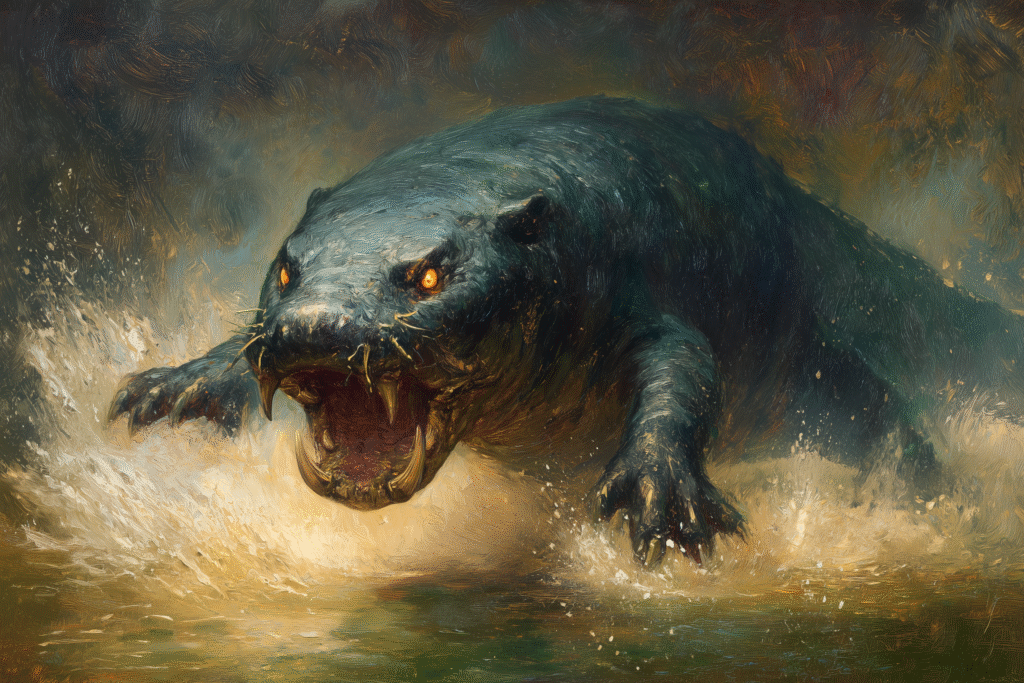
D&D 5E – Epic Monsters: Bunyip | EN World | Dungeons & Dragons | Tabletop Roleplaying Games
The bunyip is also referred to as kine pratie or katen-pai. Aboriginal Australians translate its name as “devil” or “evil spirit.” Some modern scholars link it to Bunjil, a mythic “Great Man” who created the mountains, rivers, humans, and animals.
Early Descriptions:
- First appeared in print in the Sydney Gazette (1812), described as “a large black animal like a seal, with a terrible voice which creates terror.”
- By the mid-19th century, “bunyip” became synonymous with imposter, pretender, or humbug, including the term “bunyip aristocracy.”
Cultural Accounts:
- George French Angus described it as a “water spirit” of the Moorundi people along the Murray River, often taking the unusual form of an enormous starfish.
- Robert Brough Smyth noted in 1878 that little is truly known about its form, habits, or appearance, due to the fear it inspired among Aboriginal people.
Sightings and Physical Descriptions:
- Two general types of sightings:
- Seal-like: 4–6 feet, dark-haired coat, large ears, whiskers, no tail.
- Long-necked small-headed beasts: 5–15 feet, similar coat, small tusks, horse- or emu-like head, 3-foot maned neck, horse-like tail.
- Universally described as amphibious, nocturnal predators capable of swift swimming and terrifying roars.
Explanations and Theories:
- Inland seals: Some believe bunyip myths stem from seals traveling far upriver, matching physical features like smooth fur, prominent eyes, and bellowing cries.
- Extinct megafauna: Early scientists (Dr. George Bennet, 1871) suggested memories of creatures like diprotodon, nototherium, palorchestes, or zygomaturus may have inspired the legend.
- Other theories include giant cassowaries, Australasian bitterns (whose booming calls resemble bunyip cries), or conflations with European myths such as the Irish Púca.
Notable Historical Accounts:
The variety of sightings and elusive evidence contributes to the ongoing mystery of what the bunyip actually is.
The “Challicum bunyip” etched into Fiery Creek, Victoria (1851) is a famous lost record.
Bunyip
Huge beast, unaligned
Armor Class 14 (natural armor)
Hit Points 150 (12d12+72)
Speed 20 ft., swim 50 ft.
| STR | DEX | CON | INT | WIS | CHA |
| 23 (+6) | 15 (+2) | 22 (+6) | 3 (–4) | 12 (+1) | 8 (–1) |
Saving Throws Dex +5, Wis +4
Skills Athletics +9, Perception +7, Stealth +8, Survival +4
Damage Resistances cold, thunder
Senses darkvision 120 ft., passive Perception 17
Languages —
Challenge 8 (3,900 XP)
Brave. The bunyip has advantage on saving throws against being frightened.
Hold Breath. The bunyip can hold its breath for 1 hour.
Keen Hearing and Smell. The bunyip has advantage on Wisdom (Perception) checks that rely on hearing or smell.
Terrifying Howl. The bunyip can use a bonus action to unleash a terrifying howl. Each creature of its choice within 120 feet of the bunyip that is able to both see and hear it must succeed on a DC 17 Wisdom saving throw or become frightened for 1 minute. A creature can repeat the saving throw at the end of each of its turns, ending the effect on itself on a success. If a creature’s saving throw is successful or the effect ends for it, the creature is immune to the bunyip’s Frightful Howl for the next 24 hours.
ACTIONS
Multiattack. The bunyip attacks once with its bite and twice with its slam.
Bite. Melee Weapon Attack: +9 to hit, reach 10 ft., one target. Hit: 19 (2d12+6) piercing damage, and the target is grappled (escape DC 17). Until this grapple ends, the target is restrained, and the bunyip can’t bite another target.
Slam. Melee Weapon Attack: +9 to hit, reach 5 ft., one target. Hit: 17 (2d10+6) bludgeoning damage.
Bunyip
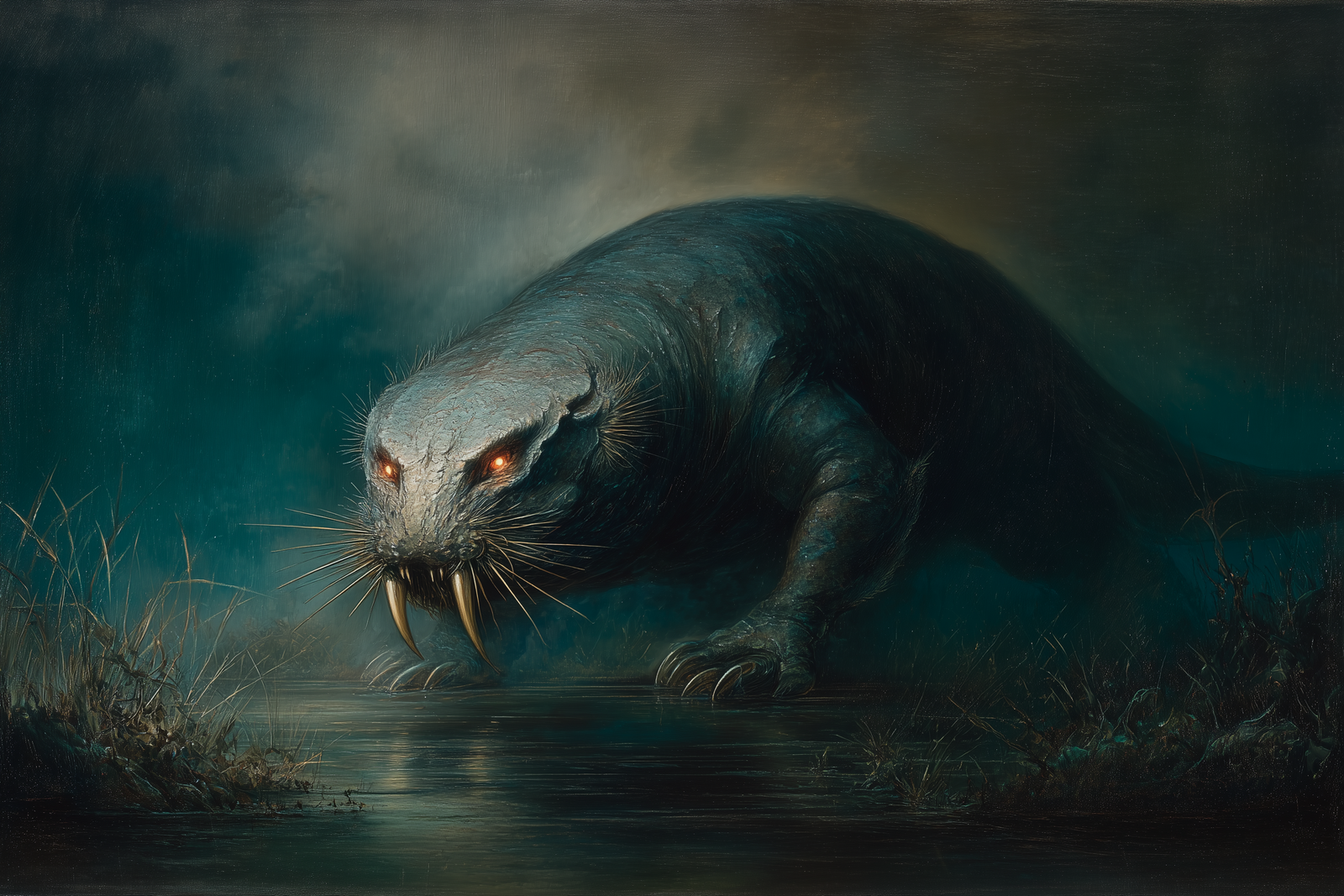
A disturbing combination of shark and seal, this brown-furred creature has a wide mouth filled with razor-sharp teeth.
The bunyip is a fierce and avid hunter, possessing a primal ruthlessness that seems almost evil in its rapacity. A bunyip typically inhabits large freshwater inlets or sheltered coastal sea caves where food is plentiful—the bunyip is equally at home in fresh or salt water. It prefers feeding on animals of Small size or larger, though it isn’t averse to eating humanoids when presented the opportunity.
Bunyips are quite territorial, and readily attack when intruders threaten their hunting grounds. Bunyips mate annually, during the late spring. During this period, bunyips become even more aggressive. After mating, couples split, with the female wandering off to find a place to birth a small litter of four to six pups. Females watch their pups for a few days, until they become independent enough for the mothers to move on.
Reports of bunyip sightings come from every end of the map. Though the accuracy of all such reports remains doubtful, enough reliable accounts exist to confirm their widespread adaptability. The species thrives in numerous ecological climes, from frigid polar fjords to idyllic tropical lagoons. The bunyip is not a deep-sea creature, and even avoids larger freshwater lakes, as it prefers to lurk near shorelines where its favorite food is more common.
Bunyip CR 3
XP 800
N Medium magical beast (aquatic)
Init +3; Senses darkvision 60 ft., low-light vision, keen scent 180 ft.; Perception +8
DEFENSE
AC 15, touch 13, flat-footed 12 (+3 Dex, +2 natural)
hp 32 (5d10+5)
Fort +5, Ref +7, Will +1
OFFENSE
Speed 10 ft., swim 50 ft.
Melee bite +7 (1d8+1/19–20 plus bleed)
Special Attacks bleed (1d6), blood frenzy, roar
STATISTICS
Str 13, Dex 16, Con 13, Int 2, Wis 11, Cha 7
Base Atk +5; CMB +6; CMD 19
Feats Improved Critical (bite)B, Skill Focus (Perception), Skill Focus (Stealth), Weapon Focus (bite)
Skills Escape Artist +5, Perception +8, Stealth +10, Swim +9; Racial Modifiers +8 Swim
SQ amphibious
SPECIAL ABILITIES
Blood Rage (Ex)
A bunyip’s blood rage ability activates whenever it detects blood in the water using its keen scent, but otherwise functions as the universal monster rule of the same name.
Roar (Su)
A bunyip’s roar is supernaturally loud and horrifying. When a bunyip roars (a standard action the creature can perform at will), all hearing creatures with 4 or fewer HD within a 100-foot spread must succeed on a DC 13 Will save or become panicked for 2d4 rounds. Whether or not the save is successful, creatures in the area are immune to the roar of that bunyip for 24 hours. This is a sonic, mind-affecting fear effect. The save DC is Constitution-based.
ECOLOGY
Environment any aquatic
Organization solitary or pair
Treasure none
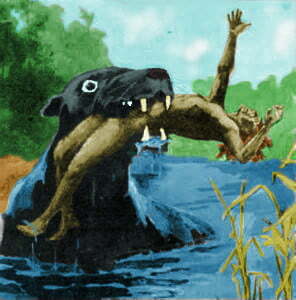
While bunyips vary in appearance, all possess similar basic physical structures. The bunyip’s head exhibits strong seal-like features, save for its shark-like jaws. Its upper torso is thick and muscular, with long, fin-like limbs. Some species even have a single, shark-like dorsal fin. The remaining portion of the body extends into a long tail. Those with fur usually only grow a short coat on the upper body in shades of pale gray, brown, or black.
Section 15: Copyright Notice
Pathfinder Roleplaying Game Bestiary 2, © 2010, Paizo Publishing, LLC; Authors Wolfgang Baur, Jason Bulmahn, Adam Daigle, Graeme Davis, Crystal Frasier, Joshua J. Frost, Tim Hitchcock, Brandon Hodge, James Jacobs, Steve Kenson, Hal MacLean, Martin Mason, Rob McCreary, Erik Mona, Jason Nelson, Patrick Renie, Sean K Reynolds, F. Wesley Schneider, Owen K.C. Stephens, James L. Sutter, Russ Taylor, and Greg A. Vaughan, based on material by Jonathan Tweet, Monte Cook, and Skip Williams.

 Buy me a coffee
Buy me a coffee